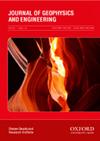Reducing the low-wavenumber dispersion error by building the Lagrange dual problem with a powerful local restriction
IF 1.7
3区 地球科学
Q3 GEOCHEMISTRY & GEOPHYSICS
引用次数: 0
Abstract
The broadband finite-difference (FD) coefficients computed by a cost function have been widely applied to suppress of numerical dispersion. Under the same condition, the FD coefficients with small low-wavenumber dispersion error will produce a more accurate numerical solution in the long-time seismic wave simulation. Thus, how to reduce the low-wavenumber dispersion error becomes a crucial problem. According to the research of zero point position at the dispersion curve for three types of cost functions, we found that the more zero points concentrate on the low-wavenumber region, the less dispersion error. Therefore, the concentration of zero points is a good way to reduce dispersion error, which can be implemented by modified wavenumbers of zero points. Then, we design a Lagrange dual problem with a restriction based on the modified wavenumbers. The Requirements for constructing the Lagrange dual problem are the optimization function and restricted condition, where the former is based on the dispersion relation, and the latter comprises the modified wavenumbers. The solution of this optimization problem, calculated by the dual ascent method, affords a less low-wavenumber dispersion error than the solution yielded by the alternating direction method of multipliers (ADMM). The theoretical analysis and numerical modeling suggest that the proposed method is superior to the existing optimal FD coefficients in reducing numerical error accumulation in low-frequency simulation.通过建立具有强局部约束的拉格朗日对偶问题来减小低波数色散误差
利用代价函数计算宽带有限差分系数已广泛应用于数值色散的抑制。在相同条件下,低波数色散误差较小的FD系数在长时间地震波模拟中可以得到更精确的数值解。因此,如何减小低波数色散误差成为一个关键问题。通过对三种代价函数色散曲线上零点位置的研究,发现零点越集中在低波数区域,色散误差越小。因此,零点集中是减小色散误差的一种好方法,可以通过修改零点波数来实现。然后,我们设计了一个基于修正波数的有限制的拉格朗日对偶问题。构造拉格朗日对偶问题的条件是优化函数和限制条件,其中优化函数和限制条件是基于色散关系的,限制条件是由修正波数构成的。该优化问题的解采用双上升法计算,其低波数色散误差小于乘法器交替方向法(ADMM)的解。理论分析和数值模拟表明,该方法在减少低频模拟数值误差积累方面优于现有的最优FD系数。
本文章由计算机程序翻译,如有差异,请以英文原文为准。
求助全文
约1分钟内获得全文
求助全文
来源期刊

Journal of Geophysics and Engineering
工程技术-地球化学与地球物理
CiteScore
2.50
自引率
21.40%
发文量
87
审稿时长
4 months
期刊介绍:
Journal of Geophysics and Engineering aims to promote research and developments in geophysics and related areas of engineering. It has a predominantly applied science and engineering focus, but solicits and accepts high-quality contributions in all earth-physics disciplines, including geodynamics, natural and controlled-source seismology, oil, gas and mineral exploration, petrophysics and reservoir geophysics. The journal covers those aspects of engineering that are closely related to geophysics, or on the targets and problems that geophysics addresses. Typically, this is engineering focused on the subsurface, particularly petroleum engineering, rock mechanics, geophysical software engineering, drilling technology, remote sensing, instrumentation and sensor design.
 求助内容:
求助内容: 应助结果提醒方式:
应助结果提醒方式:


